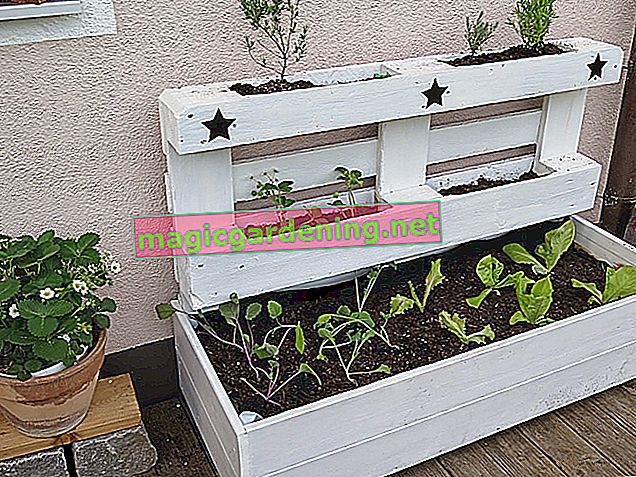
Plant sunflower properly
To plant sunflowers in the garden, wait for the ice saints to move out in May. Then follow these steps:
- Dig plant pits with twice the volume of the root ball
- Enrich the excavation with compost and horn shavings
- Plant and water the potted young plants at a distance of 50 cm
also read
- Water the sunflower properly
- The rapid growth of the sunflower
- The flowering time of the sunflower
With a garden fleece you protect the bed from late ground frosts and advancing snails.
Continue reading
Care tips
The linchpin of skilled sunflower care is a generously proportioned supply of water and nutrients. From the beginning, water the plant abundantly, directly on the root area. It is fertilized weekly with compost, horn shavings (6.39 € at Amazon *) and nettle manure. In particular, a sunflower must not lack nitrogen.
Which location is suitable?
The ideal location for the sunflower is sunny, warm and sheltered from the wind. Fresh, moist soil, rich in nutrients and without the risk of waterlogging, elicits an optimum of beauty and vitality from this ornamental flower.
Continue reading
What is the best time to plant?
You can plant a pre-grown or finished sunflower from the garden center in the bed or in the tub from mid-May. From this point on, the risk of belated ground frosts is minimal.
Continue reading
When is the flowering time?
Sunflower blooms from July to September. Newer varieties are even able to bloom well into October.
Continue reading
Cut the sunflower correctly
Annual sunflowers usually don't require pruning. Serve as a vase decoration, cut the flowers in the early hours of the morning and briefly dip the interface in boiling hot water. In contrast, pruning of perennial species and varieties contributes to improved growth and a neat appearance. How to properly prune sunflower perennials:
- To limit the height of growth, shorten the sunflower in spring
- Do not cut after the flower has appeared
- Cut off excess buds and poor shoots in good time
After pruning, the sunflower perennial is immediately watered so that it recovers quickly.
Continue reading
Watering the sunflower
The water requirement of a sunflower proves to be proportional to the high degree of evaporation through the foliage. How to properly water the flower:
- If the earth's surface dries up, it is watered
- Water in the morning and in the evening if it is dry in summer
- Keep the sunflower from waterlogging in the planter
Continue reading
Fertilize the sunflower properly
The nutritional requirements of a sunflower are at the highest level. Fertilize the gem weekly with compost and horn shavings or an alternative organic fertilizer. Since sunflowers consume nitrogen, the organic solid fertilizer is supplemented with nettle manure.
Continue reading
Sunflower in the pot
In order for the sunflower to give its best in the pot, the quality of the substrate is of utmost importance. Do not rely on commercially available potting soil, instead offer the plant this combination:
- A mix of 1 part each of compost and garden soil, enriched with horn shavings, rock flour (€ 14.95 at Amazon *) and a handful of sand
- Alternatively, a high-quality compost-based potted plant soil with a portion of lava granulate (€ 13.76 at Amazon *) or expanded clay
Since the sunflower develops considerable biomass and enormous roots, the pot should be both voluminous and stable.
Continue reading
Is sunflower poisonous?
The sunflower provides valuable seeds, rich in healthy ingredients. Only the sap and pollen can pose a health problem for allergy sufferers. When in doubt, wearing gloves and respiratory protection during planting and maintenance work prevents possible skin irritation and breathing difficulties.
Continue reading
Is the sunflower poisonous to cats?
The sunflower is in no way toxic to cats. On the contrary, the majestic plant is one of the few plants that are recommended for the cat-safe garden and balcony.
Where does the sunflower come from?
The sunflower comes from the warm regions of South America. As archaeological finds show, the Aztecs and Incas already worshiped the sunflower as a symbol for their deities.
Continue reading
The sunflower: a profile
The profile of a sunflower reveals a wealth of important details for the best possible cultivation. Pay special attention to these attributes:
- Asteraceae plant family
- Annual or perennial herbaceous plant
- Heights of growth from 40 cm to 5 meters
- Yellow, orange or red-brown pseudo-flowers with many thousands of tubular flowers
- Tubular flowers form oil-containing nuclei after fertilization
Continue reading
The composition of the sunflower
The structure of a sunflower is structured as follows:
- Deep root strands
- Coarse-haired flower stalk, mostly unbranched
- Alternate, heart-shaped leaves
- Disc-shaped flower head with yellow ray and brown tubular flowers
After being fertilized by insects, the tubular flowers transform into sunflower seeds.
Continue reading
How fast does the sunflower grow?
The growth of a sunflower takes place in these stages:
- Sow in the bed from April
- Germination after 8-14 days
- Leaves and stems grow in May
- Bud formation from June
- Beginning of flowering in July
- Average duration of the growth phase: 150 days
Continue reading
How big does a sunflower get?
The wide range of types and varieties has the right sunflower for almost every size requirement. There are small flowers from a height of 40 cm, while the giants easily reach the sky 500 cm and higher.
Continue reading
Growing sunflowers
Hobby gardeners who like to experiment simply grow their own individual sunflowers. For this purpose, you harvest the seeds of the dried flowers and store them in a dark, dry container throughout the winter. In March of the next year, sow the kernels in pots on the warm windowsill. Planted in a sunny, nutrient-rich bed from mid-May, you will be surprised by the flower results from July.
Continue reading
How to care for sunflowers as a houseplant
In order to care for a sunflower in the room according to all the rules of gardening, these measures are important:
- Place in a sunny, warm window seat
- Provide shade behind glass in the midday sun
- Determine the water requirement daily with a thumb test
- Apply liquid fertilizer once a week
If necessary, place a support rod in the soil next to the flower stalk so that a tall sunflower does not tip over.
Continue reading
Pulling sunflower on the balcony
Small sunflowers transform the balcony into a summer sea of flowers. Choosing a large bucket with a volume of more than 20 liters plays an important role in ensuring that the flowers are uninterrupted. There should not be more than 3 specimens per planter. In addition, only a nutrient-rich, well-drained substrate is possible. Check the watering requirements daily and give a dose of liquid fertilizer for flowering plants every week.
Continue reading
Care for sunflowers in the pot
In order to properly care for a sunflower in a pot, the root ball must not dry out at any time. In addition, the high need for nutrients is covered by a weekly dose of liquid fertilizer. Alternatively, you can use long-term fertilizers in the form of sticks or cones.
Is the sunflower hardy?
The classic sunflower is an annual, not hardy plant, as its botanical name Helianthus annus suggests. The genus also includes various biennial species and varieties that can withstand frost down to -20 degrees Celsius and thrive like a shrub.
Continue reading
Sow sunflowers
From March onwards, sunflowers can be sown behind glass, and from April directly into the protected bed. Sow the seeds 2-3 cm deep in a mix of sand and potting soil. At constant temperatures of 14-18 degrees, germination in the sunny location takes 8-14 days. During this time the seeds must not dry out.
Continue reading
Prefer sunflowers
From March onwards you can prefer sunflowers on the sunny windowsill, at constant temperatures of 14-18 degrees Celsius.
Continue reading
Sunflowers germinate
To put sunflower seeds in the mood for germination, fill a 15 cm pot with loose, slightly sandy garden or potting soil. Put 2-3 seeds 2 inches deep into the soil and spray them with water. In the sunny to partially shaded, warm window seat you can look forward to the first seedlings within 8-14 days.
Continue reading
The sunflower root
A sunflower root extends more than a meter into the earth. Tubers are not formed. The plant therefore leaves a first-class loosened soil for subsequent crops.
Continue reading
The leaves of the sunflower
If the sunflower lets its leaves droop sadly, it signals discomfort in this way. These causes can be hidden behind it:
- dryness
- Nutritional deficiency
- Root damage from repotting
- Waterlogging in the bucket
- Too dark location
Continue reading
The sunflower blossom
In the case of a sunflower bloom, you are actually looking at a dummy bloom, consisting of up to 15,000 individual blooms. The yellow ray florets surround the real tubular florets and only have the task of attracting insects for pollination.
Continue reading
Harvest sunflower seeds
Harvesting the rich kernels of sunflowers is not difficult. Be patient until the flower head is completely dry and tilts towards the ground. As soon as the kernels detach themselves, the harvest time begins. Put a cotton sack over the flower and cut it off with a piece of the stem. After the sack is tied, hang it up in an airy, dry place. The ripe sunflower seeds collect in it over the next few days.
Continue reading
Dry the sunflower seeds
You can create wonderful decorations with dried sunflowers. To do this, cut the stems off when the flower has not yet fully opened. Alone or tied in small bouquets, hang the sunflowers upside down in a rain-protected, air-bathed place. It can take several weeks for them to dry completely.
Continue reading
The sunflower varieties
When choosing your favorite varieties, do not limit yourself to the appearance of the flower or the height of growth. The huge range of sunflower varieties includes varieties with these special attributes:
- High nectar for bee pastures
- Extra early or particularly late flowering period
- Low or high-dose oil content
- Maximum grain yield for a rich harvest
Continue reading
The most beautiful varieties
- Tall sun gold: lush double sunflower up to 180 cm in height
- King Kong: a huge variety that easily reaches 5 meters in height
- Peach Passion: charming cultivation with peach-colored flowers
- Capenoch Star: classic sunflower perennial with a long flowering period from July to October
- Soleil d'Or: the historic sunflower with full flowers and a lifespan of several years
- Florestan: captivates with red-brown ray-flowers and delicate growth; ideal for bucket culture
The sunflower as a perennial
The multi-faceted genre not only houses the annual classics. There are also magnificent sunflowers that thrive as a perennial for at least 2 years. In return, they develop somewhat smaller flower discs and do not reach monumental heights at 120-180 cm.
Continue reading
Small sunflowers
Small sunflowers are perfect for the tub or the garden with little space. For this purpose, choose varieties with limited height gain, such as “Teddy” at 40 cm or “Double Dandy” at 60 cm. The dwarf sunflower “Pacino” only reaches a height of 25 to 30 cm.
Continue reading
The sunflower 'evening sun'
If you are looking for a flower beyond the well-trodden path of varieties, you will find it at the sunflower evening sun. This variety captivates with a branched growth and a breathtaking bloom in rich red-brown.
Continue reading








